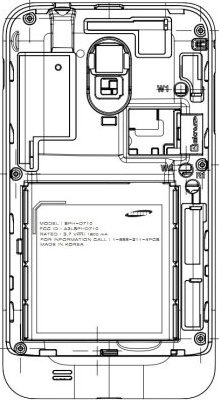 The FCC has approved the SPH-D710, which will be Sprint’s version of the Samsung Galaxy S II with WiMax support and is physically longer and wider than the reference version currently sold in Europe and Asia.
The FCC has approved the SPH-D710, which will be Sprint’s version of the Samsung Galaxy S II with WiMax support and is physically longer and wider than the reference version currently sold in Europe and Asia.
The phone will also be released with 800MHz CDMA support on the current SMR band used for Nextel iDEN service based on the waiver documentation filed with the regulator in order to certify the device. This means that the Samsung Within, when launched will support Sprint Direct Connect when launched in the Fall.
“This means that the Samsung Within, when launched will support Sprint Direct Connect when launched in the Fall.”
I don’t really agree with your conclusion, Humberto. Sprint has already announced that their initial CDMA Direct Connect handsets will be the Kyocera DuraCore & DuraMax and an unnamed Motorola. AFAIK Sprint has mentioned NOTHING about any of the current phones with CDMA800 ESMR support, such as the Samsung Trender and Evo 3D, featuring Direct Connect.
So is this the device that will become the Samsung Within when it is launched? Are there any other specifications known about it like screen size and type, processor, etc? I am currently thinking about the evo 3d since its got such a fast dual core processor but would really like to have the option of direct connect.
Presumably this is the Samsung Within. Screen size should be either 4.3 or 4.5″; there’s some debate about that at the moment. Super AMOLED+ screen. 1.2GHz dual core Exynos processor, Mali 400 GPU.
EP, thanks for the quick response! Is the Samsung Galaxy line “Pure Android” or do they have an overlay ala Sense on the HTC devices?
@EP
Samsung doesn’t file E SMR waivers unless the phone has the radio to support it. The fact that the waiver has been filed is more than enough evidence that Sprint is preparing more devices than have been “officially confirmed” by Sprint for Sprint Direct Connect’s launch.
I understand that this phone, along with the Evo 3D, Samsung Trender, etc. have the CDMA800 ESMR radio within them. However, the waiver (btw link doesn’t seem to work) doesn’t mention anything about mandating dispatch or direct connect capability for handsets that have that particular radio. If you look at an Evo 3D for example, there isn’t even a button to use for the direct connect feature. I remain unconvinced that any handsets other than the Kyocera DuraMax and DuraCore and the unnamed Motorola will be able to use the new Direct Connect feature even if they do happen to have CDMA800 ESMR radio.
@Steven Goldfein it will likely be running Touchwiz 4.0
Humberto I am afraid I think you have drawn an incorrect conclusion.
Sprint’s new CDMA DIrect Connect is no different than a data call with VoIP running on top. It does not require or mandate 800 support. That support is there for an entirely different reason. Let’s face it, iDen is shrinking and doesn’t need all that capacity any longer. Their latest reports shows ~5mil subscribers, down from over 20mil at the merger. They are most likely going to start using some of that free spectrum instead of leaving it sit dormant for CDMA to add capacity to their current network.
I think some of you are reading something entirely different from the article, which may be my fault for not clarifying.
Sprint Direct Connect solves the biggest issue that kept QChat from working the first time around, which is the need for a dedicated channel and band for full functionality. The reason the ESMR waivers are filed for select phones is because the support for CDMA on the ESMR band is going to be included in the phone, but it will initially be dormant, requiring a firmware update for full operation.
Now, why else would smartphones be shipped with ESMR 800 support, if not solely for additional capacity? It’s no secret that Sprint Direct Connect is going to roll out on the first phase of the iDEN sunset this Fall and the Motorola smartphone they keep teasing is just the one phone they’re willing to admit to releasing with Sprint Direct Connect because it’s tradition to have the functionality on a Motorola phone.
What if Sprint quietly decided to push all of their partners to add Sprint Direct Connect because it solves the other problem of not having smartphones with Direct Connect, which was the biggest failing of the first QChat roll out? If I’m wrong, I’m more than willing to admit that, but all of the mounting evidence is proving my theories correct so far.